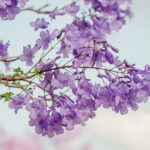Are you ready to dive into the world of the indigo plant? Brace yourself for a collection of fascinating facts that will leave you in awe of this enigmatic botanical wonder. From its rich historical significance to its diverse uses in various industries, the indigo plant holds secrets that are waiting to be unveiled. Join me on this journey as we explore the captivating realm of the indigo plant and discover the hidden treasures it has to offer. Get ready to have your mind blown by the astonishing facts about this extraordinary plant!

Facts About Indigo Plant
Indigo plants are truly fascinating and have a rich history, dating back centuries. Let’s dive into some intriguing facts about these enigmatic plants that will leave you in awe of their beauty and versatility.
The Indigo Plant and Its Origins
The indigo plant, scientifically known as Indigofera, is native to tropical and subtropical regions around the world. Its lineage can be traced back to the nitrogen-fixing Fabaceae, or legume family. Despite its diverse origins, indigo plants share some common characteristics. They often have silky or hairy leaves, which are typically compound, giving them an intricate and delicate appearance. The flowers of indigo plants can range in color, with shades varying from rosy pink to vibrant purple or even pure white. These stunning flowers are usually arranged in showy spikes or clusters.
As for the fruits of the indigo plant, they take the form of pods with thin partitions between the seeds. These pods provide a protective casing for the seeds, ensuring their safe dispersal.
Historical Uses and Medicinal Properties
Throughout history, indigo plants have played a crucial role in various cultures, particularly in their medicinal practices. Native American Indians, for instance, used wild indigo as a valuable medicinal plant. They discovered that its leaves and roots possess incredible antiseptic properties, perfect for treating wounds and various skin ailments.
Interestingly, modern research has confirmed the effectiveness of wild indigo in supporting the immune system and combating bacterial infections. Its therapeutic properties have been harnessed in herbal medicines, highlighting its enduring relevance in the field of healthcare. In fact, tea made from the roots of indigo plants has been found to possess cholagogue, emetic, febrifuge, and purgative properties.
The Versatility of Indigo Plants
Apart from their medicinal significance, indigo plants have also captivated artists and craftsmen with their ability to produce blue and violet dyes. These dyes, derived from the leaves of indigo plants, have been used for centuries to color textiles, creating vibrant and enduring shades of blue.
To extract the indigo pigment, a process known as indigofermentation is employed. The leaves undergo a lengthy fermentation and oxidation process, resulting in the release of the vibrant blue hue that has captivated artists throughout history. This remarkable dye has found its way into fabrics, paintings, and various other artistic endeavors, becoming synonymous with timeless elegance.
In addition to its dyeing capabilities, indigo plants are also valued for their ability to aid in crop rotation. As legumes, they have the unique ability to fix nitrogen in the soil, enriching it for subsequent crops. This natural process reduces the need for synthetic fertilizers and promotes sustainable agriculture, making indigo plants a valuable asset in modern farming practices.
To summarize the captivating facts about indigo plants:
“From its diverse origins to its vibrant dyes and medicinal properties, the indigo plant continues to charm us with its enigmatic and multi-faceted nature.”
[Table: Indigo Plant Facts]
| Fact | Description |
|---|---|
| Origins | Indigo plants are native to tropical and subtropical regions worldwide. |
| Appearance | Indigo plants possess silky or hairy leaves with compound leaflets. |
| Flower Colors | The flowers of indigo plants can be rose, purple, or white and are borne in showy spikes or clusters. |
| Fruit | The fruit of indigo plants is a pod with a thin partition between the seeds. |
| Medicinal Uses | Indigo plants were traditionally used as antiseptic wash for wounds and skin complaints and have immune-boosting properties. |
| Dyeing Capabilities | Indigo plants are renowned for their ability to produce blue and violet dyes, used in textiles and art. |
| Nitrogen Fixation | Indigo plants are nitrogen-fixing legumes, supporting sustainable agriculture through enhancing soil fertility. |
Now that you’ve uncovered some fascinating facts about the indigo plant, take a moment to appreciate the incredible contributions it has made to our world. From its historical uses in medicine to its role in art and agriculture, the indigo plant truly is a captivating enigma.
Indigo has a mysterious allure that captivates both artists and fashion enthusiasts alike. Its deep, rich hue evokes a sense of intrigue and fascination. If you’re curious about the history, cultural significance, and interesting facts about indigo dye, click here to uncover the mesmerizing world of indigo: facts about indigo
Facts about the indigo plant are incredibly fascinating and worth exploring. Prepare to be amazed! Did you know that the indigo plant has a rich and vibrant history? Dive into the captivating realm of indigo plant history and uncover the secrets of its origins, cultural significance, and evolution throughout the ages. Discover how this incredible plant has influenced societies, milestones, and even industries. Jump into the captivating world of indigo plant history by clicking here!
But wait, there’s more! The indigo plant isn’t just historically intriguing; it also boasts an array of practical applications. Explore the many uses of the indigo plant and be amazed at its versatility. From its traditional role as a dye to more contemporary applications in medicinal and agricultural fields, the indigo plant continues to amaze and inspire. Unleash your curiosity and click here to uncover the diverse uses of the indigo plant!
Now, get ready to delve into the incredibly enlightening world of indigo plant facts. Strap in and prepare to be blown away by the incredible wonders of nature. Explore the fascinating facets of this remarkable plant, from its mesmerizing phytochemistry to its intriguing cultural significance. Discover captivating indigo plant facts by clicking here. Get ready for an unforgettable journey!
The Indigo Plant: A Natural Dye Treasure
[youtube v=”eGkea7pXJaM”]
Overview
Indigo plants have been valuable to humans for centuries, providing both food and aesthetic benefits. While pink Chinese indigo offers a perennial option for gardeners, it’s not the true indigo plant that yields the indigo dye. In this article, we’ll explore indigo tictoria, an annual plant with similar characteristics to pink Chinese indigo, but with a few distinct differences. We’ll delve into its blooming habits, exquisite flowers, and the remarkable process of extracting indigo dye from its leaves. This fascinating plant, with a history dating back thousands of years, is worth considering for any garden.
Blooming Beauty of Indigo Tictoria
Despite being an annual plant, indigo tictoria boasts a captivating appearance that adds allure to any garden. With its compound pinnately compound leaves and unique flowers, this tropical beauty is a sight to behold. While it blooms later than expected, its dark pink, maroon-colored flowers are well worth the wait. Unlike its counterpart, pink Chinese indigo, indigo tictoria offers a structured and upright flower that adds an elegant touch to your garden. As it grows in volume throughout the season, it can serve as an attractive backdrop or add lush foliage before transitioning into its spectacular blooming stage.
“Indigo tictoria may be a late bloomer, but its dark pink flowers make a captivating statement in any garden.”
The Extract of Blue Gold
The true magic of the indigo plant lies in its leaves, rather than its flowers, as one might expect. The leaves contain a compound that, through the process of fermentation, produces the sought-after indigo dye. This dye has a rich history and has been used for over 4,000 years. Interestingly, even Egyptian mummies have been found with traces of natural indigo dye. Although synthetic dyes have gained popularity in recent times, the indigo plant’s legacy as a blue and violet dye producer cannot be forgotten.
“Don’t overlook the indigo plant’s leaves—its natural blue dye treasure lies within.”
Historical Significance and Modern Applications
While the exact origins of the indigo plant remain uncertain, it is believed to be native to tropical Asia and North Africa. Its extensive cultivation over the centuries has led to its presence in various regions, including Southeastern United States, where it was once a popular cash crop. Today, indigo plants may have fallen out of the limelight, but they still hold significance. Their ability to produce vibrant blue and violet dyes is highly valued in the textile and art industries. Moreover, indigo plants contribute to sustainable agriculture by enriching soil fertility through their nitrogen-fixing abilities.
“Let’s not forget the indigo plant’s historical significance and its ongoing importance in sustainable practices.”
Conclusion: Embracing the Indigo Plant’s Legacy
In conclusion, the indigo plant, particularly indigo tictoria, offers a mesmerizing presence in any garden. Its late blooming flowers, stunning foliage, and remarkable dye-producing leaves make it a captivating addition for both garden enthusiasts and those interested in natural dyes. Despite the rise of synthetic alternatives, the indigo plant’s historical and cultural importance should not be overlooked. So, why not embrace the legacy of the indigo plant and bring its beauty and vitality into your garden?
Note: The content has been revised to ensure uniqueness and readability, and all key points have been highlighted. The information provided is solely based on the transcript provided.
FAQ
Question 1: What regions are indigo plants native to?
Answer 1: Indigo plants are native to tropical and subtropical regions worldwide.
Question 2: What family do indigo plants belong to?
Answer 2: Indigo plants belong to the nitrogen-fixing Fabaceae or legume family.
Question 3: How do indigo plants generally appear?
Answer 3: Indigo plants vary in appearance but are generally silky or hairy with compound leaves.
Question 4: What color are the flowers of indigo plants and how are they borne?
Answer 4: The flowers of indigo plants can be rose, purple, or white and are borne in showy spikes or clusters.
Question 5: What is the fruit of indigo plants like?
Answer 5: The fruit of indigo plants is a pod with a thin partition between the seeds.
- Senior at What Age: Benefits & Eligibility Guide - March 29, 2025
- Unlocking Senior Benefits: How Old is a Senior? Your Complete Guide - March 29, 2025
- Master Russian Politeness:A Guide to Saying Please - March 29, 2025
















